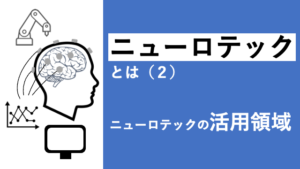What is Neurotech (Braintech) (1):
Basic technologies and issues supporting Neurotech (Braintech)
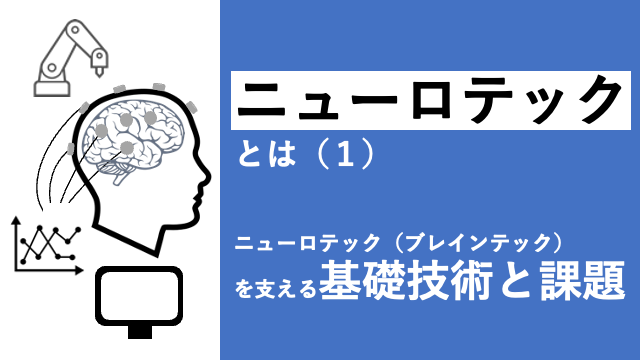
What is Neurotech (Braintech)?
Neurotech, also known as brain tech, is a technology that applies "neuroscience", including technology for monitoring brain activity, stimulating the brain to improve treatment and performance, and supporting these technologies. " is a generic term for.
There are a number of applied technologies, such as technology for measuring brain activity, stimulation technology for controlling the brain, and brain-machine interface (BMI) technology for operating machines (machines) by means of brain waves and other means. originally, these technologies were mainly aimed at healthcare/medical applications, such as detecting tumours and other brain abnormalities, and treating neurological disorders with drugs and electrical stimulation.
However, product creation is being promoted by companies around the world, not only for clinical use but also in non-medical areas such as lifestyle and education, due to the following advances
- Advances in analytical technology: developments in data science have increased the amount of information that can be extracted from brain activity.
- Advances in measurement technology: improved measurement device technology makes it easier to extract brain activity.
- Advances in stimulation technology: establishment of methods of brain stimulation other than drugs and electricity, such as neurofeedback.
Currently, for businesses, development has started in related areas such as automobiles and construction. Meanwhile, for customers, attention is being focused on lifestyle areas such as improving sleep and concentration.
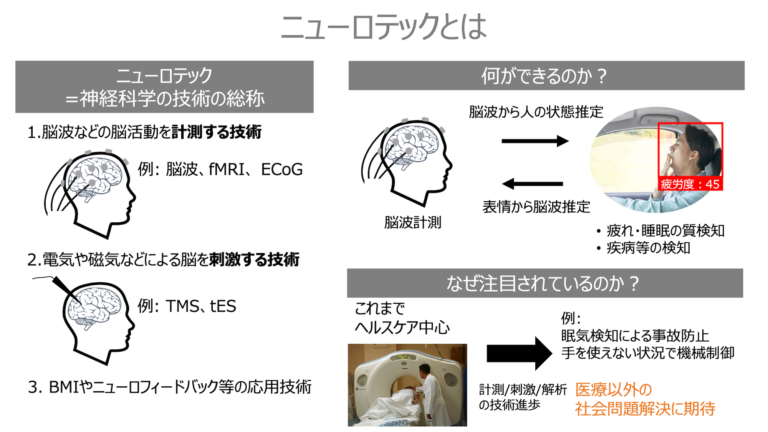
In ARATA since its founding in 2013, the company has been conducting research and development in neurotech and has developed various businesses, including fMRI and other brain data analysis services and brain state sensing solutions.
In this article, we would like to briefly summarise the technologies behind neurotech, give an overview of current areas of implementation, representative companies and country-specific projects, and finally introduce our initiatives.
1. basic technologies and issues supporting neurotech (brain tech)
Typical technologies supporting neurotech include 'measurement' technology, which detects information from brain activity, and 'stimulation' technology, which writes information into brain activity (Fig. 2). Each of these technologies has its own merits and demerits, depending on the measurement and stimulation devices, and must be used appropriately for different purposes (Fig. 3).
There are three key elements in understanding 'measurement' and 'stimulus' technologies. These are temporal resolution, spatial resolution and invasiveness. These three factors make it easier to understand the basic neurotechnologies.
Temporal resolution: how precisely the brain information can be detected and stimulated in time
Spatial resolution: how spatially precise the brain information can be detected or stimulated.
Invasiveness: is there physical damage to the brain to use the device?
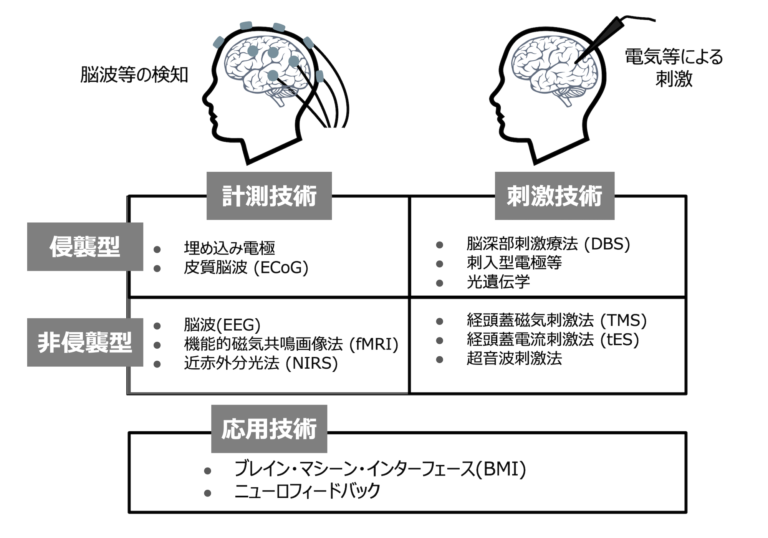
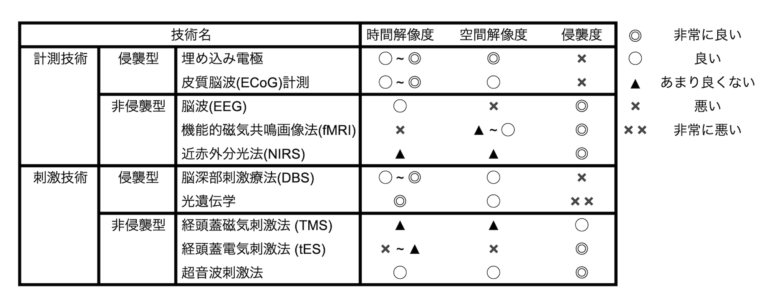
(For measurement techniques, in particular the spatial resolution of ECoG and fMRI [Ordikhani-Seyedlar et al. 2016; Thukral et al. 2018]. For the stimulation technology, we drew on 'How far can human capabilities be extended if we connect the brain and artificial intelligence? At the forefront of brain-AI fusion' (by Daichi Konno and Yuji Ikeya). Regarding the spatial resolution of optogenetics, it is assessed as equivalent to deep brain stimulation therapy because the technology to stimulate the brain locally has not been established, although it can be stimulated according to cell type).
Advantages & disadvantages of each technology supporting neurotech.
Both 'measurement technology' and 'stimulation technology' can be divided into 'invasive' and 'non-invasive' types. Invasive devices refer to devices that involve some form of trauma, such as the implantation of electrodes in the brain, and the low acceptability associated with such invasiveness is a disadvantage. On the other hand, they have the advantage of being able to acquire signals from the brain more directly and thus acquire information with higher temporal and spatial resolution. Conversely, non-invasive devices have the advantage of being less invasive, but also have the disadvantage of lower temporal and spatial resolution. There are also differences in whether each technology is portable or not, and it is necessary to use the technology according to the application.
1.1 Technology for measuring brain activity
By "measuring brain activity", it is possible to detect what a person is feeling, or what mental and physical abnormalities the brain is detecting subconsciously, even if the person is not feeling them. Monitoring electrical brain activity requires a device for this purpose.
In addition, the device is designed to
Invasive, where electrodes are implanted directly into the brain, and
There are two main types of non-invasive systems that measure brain activity without implanted electrodes.
Invasive measurement technology: implanted in the head or brain
The invasive type measures brain activity with low noise and good accuracy and temporal resolution. They require electrodes to be implanted in the head, require surgery and have the major disadvantage of not being able to monitor brain activity from many brain regions.
Typical methods include.
- Multipoint electrode measurement with electrodes implanted in the brain.
- Cortical electroencephalography (ECoG, electrocorticogram) measurements using a film-like sheet implanted in the cranium
There are.
More recently, stentloads (Stentrode) have been developed, in which a stent with electrodes (a medical device used to widen blood vessels, tracheas and other tubular internal organs) is implanted in the blood vessel.
Non-invasive measurement technology: types that fit into headgear or scanners
Unlike the invasive type, the non-invasive type does not require surgery and brain activity can be measured by wearing headgear or entering the scanner. It therefore has the advantage of being easier to measure than the invasive type. On the other hand, there are disadvantages, such as the need to attach the instrument each time a measurement is taken and the signal accuracy is not very good.
Typical methods include.
- Electroencephalogram (EEG) measurement, which detects electrical signals in the head
- Functional magnetic resonance imaging (fMRI) andnear-infrared spectroscopy (NIRS) to detect signals related to brain oxygen metabolism.
These include.
1.2 Brain-controlled stimulation technology
Typical brain stimulation techniques include deep brain stimulation (DBS), transcranial magnetic stimulation (TMS) and transcranial electrical stimulation (tES), which stimulate the brain by means of drugs, magnetism or electrical stimulation. There are also methods that do not rely on magnetic or electrical stimulation , such as ultrasound stimulation, optogenetics and neurofeedback. Methods other than drugs and neurofeedback are described here.
As with measurement technology, there is a difference between invasive and non-invasive types of brain stimulation.
Invasive stimulation technology: type of direct stimulation of the head and brain
Stimulation electrodes may be attached to a set of implanted electrodes that detect information about the brain. Deep Brain Stimulation (DBS), which uses this to stimulate deep areas of the brain such as the thalamus, is already used in the medical field to treat conditions such as Parkinson's disease, epilepsy and depression.
Another method is optogenetics, which uses specialised light-sensitive proteins to manipulate neuronal activity. However, the introduction of special proteins requires the introduction of genetically modified neurons, which is highly invasive.
In recent years, the technology has also been applied to stimulation while measuring, using stinging electrodes with embedded measurement technology.
Non-invasive stimulation technology: type of indirect stimulation of the head and brain
Transcranial magnetic stimulation (TMS), which uses magnetism, andtranscranial electrical stimulation (tES), which uses electric current, are typically used. Ultrasound stimulation, which uses ultrasound to vibrate and stimulate specific areas of the brain, is also currently undergoing basic research and is expected to be applied in the future.
1.3 Applied technology
APPLIED TECHNOLOGIES SUCH AS BMI AND NEUROFEEDBACK HAVE ALSO BEEN DEVELOPED FOR USE IN BODY CONTROL SUPPORT AND REHABILITATION BY COMBINING MULTIPLE TECHNOLOGIES.
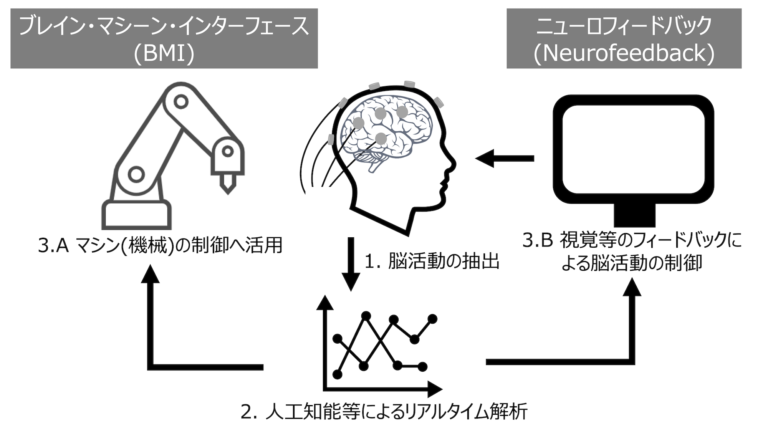
BOTH 1. EXTRACT BRAIN ACTIVITY WITH MONITORING DEVICES; 2. EXTRACT SPECIFIC INFORMATION IN REAL TIME; BMI MANIPULATES 3.A ROBOTIC ARMS, SCREEN CURSORS, AVATARS, ETC. NEUROFEEDBACK USES 3.B VISUAL AND OTHER FEEDBACK TO CONTROL HUMAN BRAIN ACTIVITY.
BRAIN-MACHINE INTERFACE (BMI)
BMI is a technology that uses brain information to create a direct interface between brain and machine . It is achieved by extracting human intentions using brain activity measurement technology such as electroencephalography (eeg) and analysis technology such as artificial intelligence. When the output connecting the brain to the computer is a computer, it is also called a brain-computer interface (BCI).
neurofeedback
Neurofeedback is a technology that provides real-time feedback of brain activity signals to humans by visual and auditory means. The aim is to direct brain activity towards a desired activity, for example, to promote autonomous brain learning by receiving sound or visual feedback when a desired brain wave appears. (Figure 4: Neurofeedback).
The ability to control brain activity non-invasively has led to developments in the medical field, such as the treatment of psychiatric and other disorders to control abnormal brain activity, and rehabilitation to promote appropriate physical control.
Today, the technology is also attracting attention for its use in sports and everyday life as a technology to improve specific abilities such as attention and motor skills.
2. areas of application of neurotech
Clinical research and development on simple detection devices and treatment and prevention methods for mental illness and developmental disorders has traditionally been conducted in the healthcare domain. There has also been development of the use of BMI as a treatment and rehabilitation method.
At the same time, the use and introduction of neurotech is being considered not only in the healthcare domain, but also in other domains, such as automotive and construction. (Figure 5: Expansion of neurotech application areas).
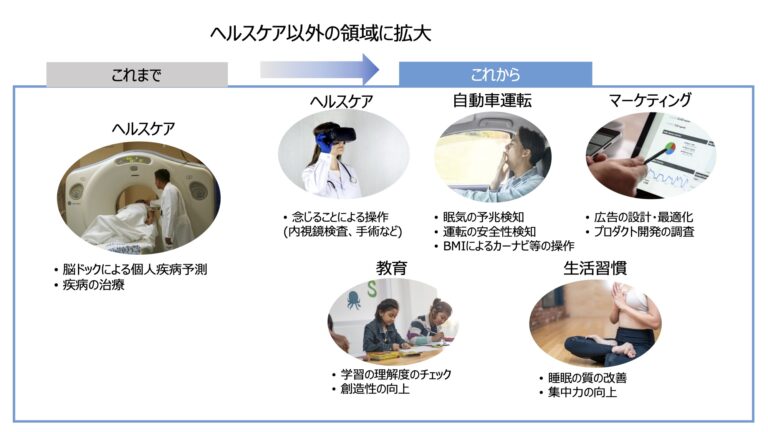
In the automotive industry, development has begun in areas such as detecting signs of drowsiness and checking safety for distractions to prevent accidents by putting headgear-type EEG measuring devices on drivers (*1).
(*1) Hitachi Construction Machinery acquires Australian company to analyseoperators' brainwaves for advancedmine operation management.
Safety management of hazardous work is also an important issue in the construction domain, and the use of neurotech to detect lack of attention is attracting attention. In addition, efforts are being made to improve productivity by linking VR with BIM (Building Information Model), a system for managing 3D models of building elements such as walls/pillars, etc. (*2), and there is growing interest in further improving productivity by utilising BMI. The following are some of the most important issues.
(*2) VR speeds up architectural decision-making! HPMobileWorkstation contributes to the construction of well-designed facilities
In the marketing domain, the use of neurotech is also referred to as neuromarketing. Understanding the brain activity of the consumer's buying process can help to promote marketing efficiency. It is also used to gather information on the effectiveness of advertisements and responses to products based on brain responses when advertisements and products are shown to consumers.
In education and lifestyle areas, monitoring brain activity to detect drowsiness, fatigue and stress may help to check comprehension, improve sleep and concentration.
As well as improving children's memory and concentration, it is also expected to assist with age-related declines in ability. The potential for use in improving creativity in desk-based work is also attracting attention. Relatedly, similar capacity enhancement is an important topic in sport.
In the future, smart cities using bmi for healthy urban development may emerge.
(Authors: Taiyo Hamada, Satoshi Demoto, Shuntaro Sasai, Ayumi Kusano)
Table of Contents
1. Basic technologies and issues underpinning neurotech
2. Areas of application of neurotech
3. The state of neurotech in companies and countries
4. ARAYA initiatives
5. Summary

 Contact Us
Contact Us

